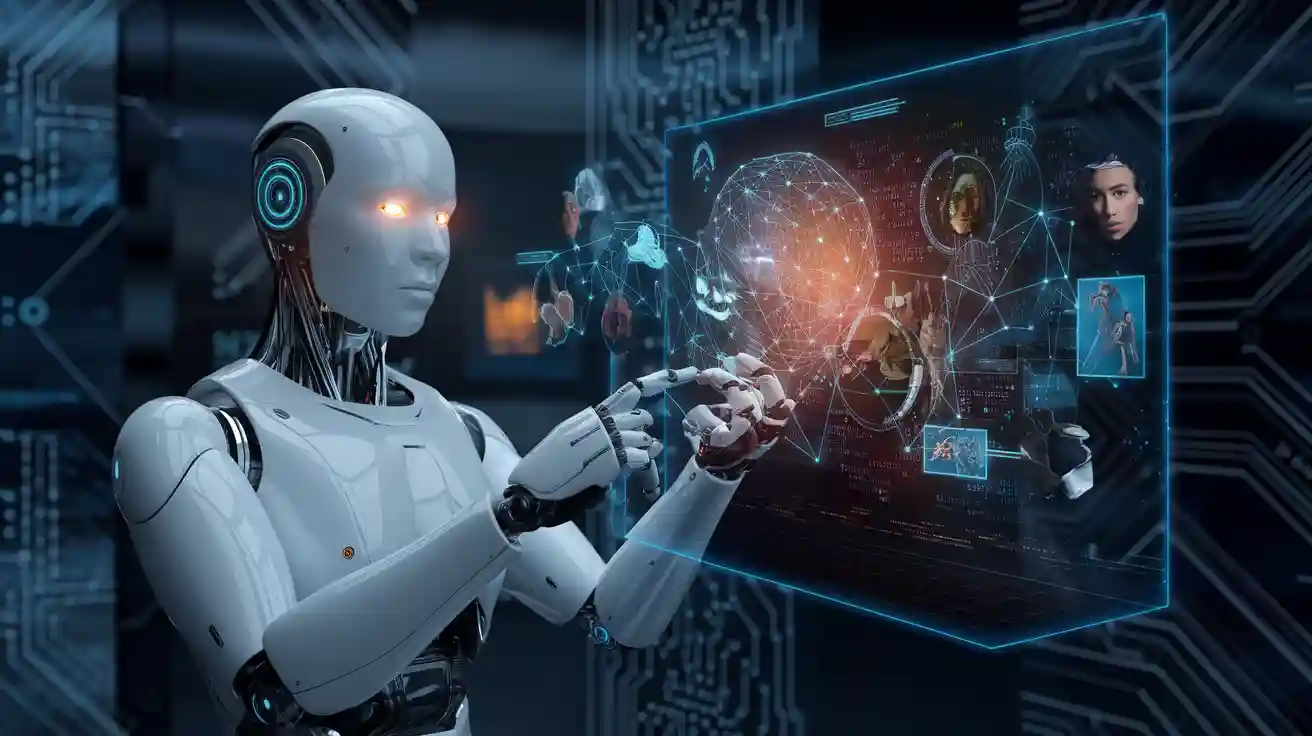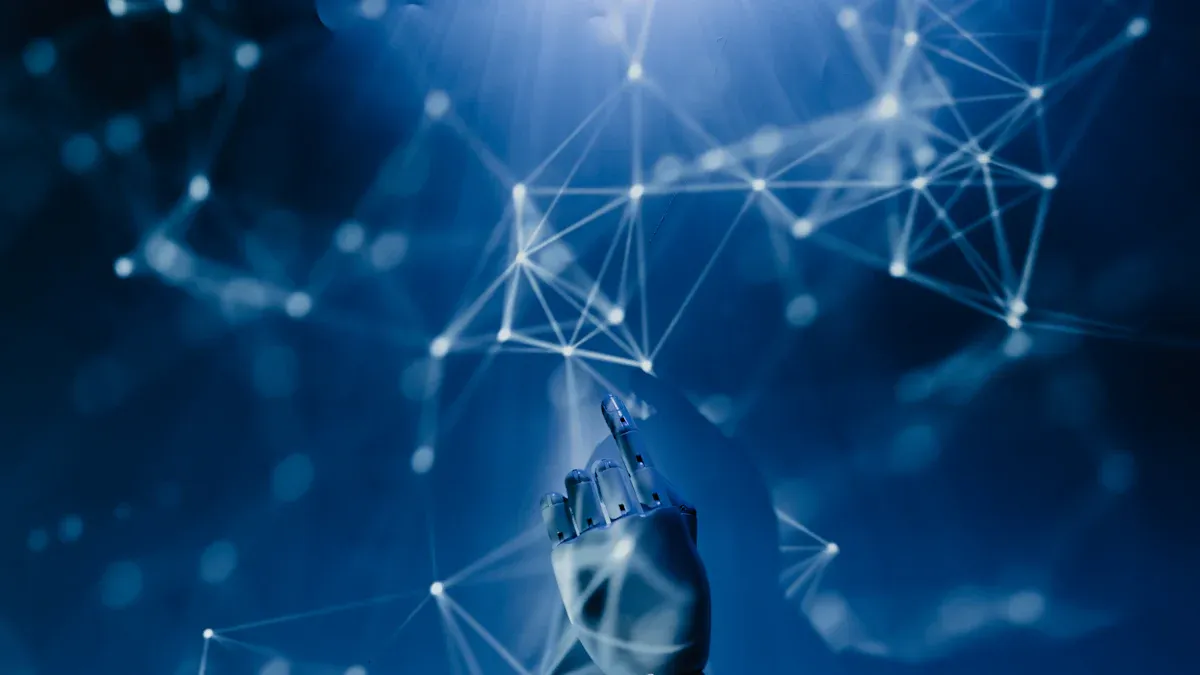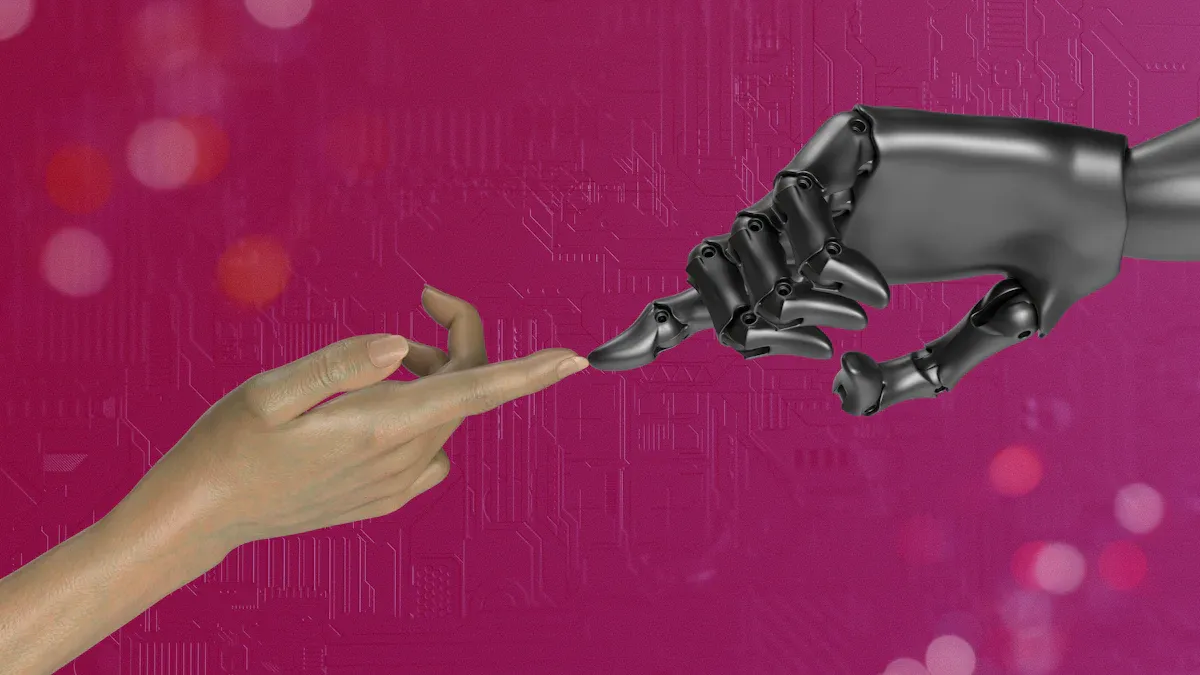
Self-supervised learning enables machine vision systems to learn directly from unlabeled data. It uses patterns within the data itself to create tasks that act as supervisory signals. These systems recognize shapes, textures, and spatial relationships without human-labeled datasets. This approach reduces costs and improves scalability for large-scale applications. By leveraging self-supervised learning, machine vision systems adapt to diverse environments and solve complex visual problems with greater efficiency. The Self-Supervised Learning machine vision system opens doors to innovative applications in fields like healthcare, robotics, and autonomous driving.
Key Takeaways
-
Self-supervised learning helps machines learn from data without labels.
-
This method uses the data itself to create learning signals.
-
It removes the need for humans to label lots of data.
-
Self-supervised learning helps models work well on many tasks.
-
It makes them useful for things like finding objects in pictures.
-
Tasks like guessing how an image is rotated teach useful skills.
-
These skills help machines do better in real-world situations.
-
But there are problems, like needing strong computers and good data.
-
These issues must be solved to make it work well.
Understanding Self-Supervised Learning
Comparison with Supervised and Unsupervised Learning
Self-supervised learning bridges the gap between supervised and unsupervised learning by combining the strengths of both approaches. Supervised learning relies on labeled datasets, where each input is paired with a corresponding output. This method achieves high accuracy but demands extensive human effort to label data, which limits scalability. Unsupervised learning, on the other hand, works with unlabeled data to identify patterns or clusters. While it reduces dependency on labeled datasets, its applications are often constrained to simpler tasks.
Self-supervised learning introduces a novel paradigm. It generates supervisory signals from the data itself, eliminating the need for manual labeling. For instance, a machine vision system might predict missing parts of an image or identify relationships between patches within the same image. This approach enables models to learn complex representations without external annotations, making it more versatile than unsupervised learning and less resource-intensive than supervised learning.
Recent studies highlight the advantages of self-supervised learning over traditional methods. A comparison of model accuracy in supervised and semi-supervised settings reveals statistically significant improvements with self-supervised techniques. The table below illustrates these findings:
|
Metric |
Description |
Statistical Significance |
|---|---|---|
|
A |
Model accuracy in a supervised setting |
– |
|
A_semi |
Accuracy using semi-supervised methods |
p < 0.05 |
|
Result |
A_semi > A |
p < 0.05 |
These results underscore the potential of self-supervised learning to outperform conventional approaches in machine vision tasks.
Key Features of Self-Supervised Learning
Self-supervised learning stands out due to its unique features that make it ideal for machine vision systems. First, it leverages pretext tasks to create supervisory signals. These tasks, such as predicting the rotation of an image or reconstructing missing pixels, encourage models to learn meaningful representations. By focusing on the inherent structure of data, self-supervised learning enables systems to understand complex visual patterns.
Second, scalability is a defining characteristic. Experiments conducted on diverse datasets, including object-centric, scene-centric, and web-crawled data, demonstrate the ability of self-supervised learning to handle large-scale datasets efficiently. The table below highlights its scalability and performance improvements:
|
Aspect |
Description |
|---|---|
|
Method |
Introduces a semantic bottleneck to MIM for improved objectness at patch-level token representation. |
|
Data Types |
Experiments conducted on object-centric, scene-centric, web-crawled, and ego-centric data. |
|
Scalability |
Demonstrates superior data efficiency and scalability when scaled with million-scale datasets. |
|
Performance Improvements |
Achieves significant improvements in image recognition, scene understanding, and robot learning evaluations. |
Finally, self-supervised learning excels in generalization. Models trained using this approach adapt to diverse tasks, from object detection to image segmentation. Empirical analyses validate its effectiveness using metrics like overlap and inter-class aSTD. These metrics reveal strong correlations with error rates, proving that self-supervised models can achieve competitive performance compared to supervised ones. For example:
-
Overlap and inter-class aSTD metrics show correlation coefficients of r=0.99 and r=0.96, respectively.
-
Models like MoCo v3, DINO, and MAE demonstrate robust performance across various machine vision tasks.
These features make self-supervised learning a transformative approach for modern machine vision systems.
Mechanisms of Self-Supervised Learning
Self-supervised learning relies on innovative mechanisms to extract meaningful patterns from unlabeled data. These mechanisms enable computer vision models to learn robust visual representations, making them effective for a wide range of tasks. This section explores three key approaches: pretext tasks, contrastive learning techniques, and other self-supervised learning methods.
Pretext Tasks in Machine Vision
Pretext tasks play a foundational role in self-supervised learning algorithms. These tasks create artificial objectives that guide models to learn useful features from data. For example, a model might predict the rotation angle of an image or reconstruct missing parts of a picture. By solving these tasks, the model develops a deeper understanding of visual structures.
Empirical benchmarks highlight the effectiveness of pretext tasks in machine vision. The table below summarizes key findings:
|
Evidence Type |
Description |
|---|---|
|
Pretext Task Complexity |
Increasing task complexity does not always improve feature learning. |
|
Dataset Distribution |
Spatio-temporal tasks excel on datasets like UCF101 and Diving48. |
|
Performance Drop |
Contrastive tasks show larger performance drops compared to non-contrastive tasks. |
Case studies further demonstrate the impact of pretext tasks. For instance, the PT4AL framework uses pretext tasks to enhance active learning. However, results vary depending on the quality of the pretext task and the dataset used. These findings emphasize the importance of designing tasks that align with the model’s capacity and the data’s properties.
Contrastive Learning Techniques
Contrastive learning has emerged as a powerful approach within self-supervised learning. This technique trains models to distinguish between similar and dissimilar data points. For instance, a model might learn to identify whether two image patches belong to the same object or scene. By maximizing the similarity between related data points and minimizing it for unrelated ones, contrastive learning enables models to capture meaningful relationships.
Recent experiments reveal significant performance improvements with contrastive learning techniques. Key observations include:
-
Enhanced model convergence using a decomposable loss function compared to conventional loss functions.
-
Consistent convergence to optimal solutions in synthetic data experiments.
-
Superior performance in downstream tasks like zero-shot image classification and image/text retrieval.
These results highlight the versatility of contrastive learning in self-supervised visual representation learning. With careful hyperparameter tuning, methods like SimCLR can achieve performance levels comparable to advanced techniques such as VICReg. This underscores the potential of contrastive learning to bridge performance gaps across different self-supervised learning algorithms.
Other Self-Supervised Learning Methods
Beyond pretext tasks and contrastive learning, other self-supervised learning methods contribute to the advancement of computer vision models. Non-contrastive approaches, for example, focus on learning representations without explicitly comparing data points. Techniques like BYOL (Bootstrap Your Own Latent) and SimSiam achieve this by encouraging models to predict their own representations across augmented views of the same data.
These methods offer unique advantages. They reduce the reliance on large batch sizes and negative samples, which are often required in contrastive learning. Additionally, they demonstrate resilience to performance drops in scenarios with limited computational resources. However, their success depends on careful architectural design and optimization.
Self-supervised learning mechanisms, including pretext tasks, contrastive techniques, and non-contrastive methods, leverage vast amounts of unlabeled data to train models effectively. They have shown competitive or superior performance compared to traditional supervised learning, particularly in scenarios where annotated data is scarce. This scalability and cost-effectiveness make self-supervised learning algorithms an attractive choice for real-world applications.
Applications in Machine Vision Systems

Object Detection and Recognition
Self-supervised learning has significantly improved object detection and recognition tasks in machine vision systems. Models pre-trained on unlabeled datasets can be fine-tuned for specific use cases, reducing the dependency on large labeled datasets. This approach enhances efficiency and scalability, making it ideal for applications like autonomous driving and surveillance.
Evaluation metrics such as mean average precision (mAP@0.5:0.95) and average precision (AP@0.5:0.95) demonstrate the effectiveness of these models. For instance, mAP@0.5:0.95 measures the accuracy of object localization across various intersection-over-union (IoU) thresholds, while AP@0.3 provides insights into localization performance for smaller objects. The table below highlights these metrics:
By leveraging self-supervised learning, machine vision systems achieve higher accuracy and efficiency in detecting and recognizing objects across diverse scenarios.
Image Segmentation and Classification
Image segmentation and classification benefit greatly from self-supervised learning techniques. Models trained using this approach excel in tasks requiring precise boundary detection and accurate categorization. Deep learning methods like U-Net and Mask R-CNN achieve superior intersection-over-union (IoU) scores, indicating their effectiveness in segmentation tasks.
Machine learning approaches, such as Random Forests, show slight improvements in IoU scores when combined with user interaction. However, naive methods like thresholding and edge detection exhibit negligible improvements, highlighting their limitations in complex scenarios. Self-supervised learning addresses these challenges by enabling models to learn from unlabeled data, reducing the need for time-consuming annotations.
Performance increases with the volume of data used for training. High-resolution image training further enhances accuracy, although training only the final iterations can yield similar results with reduced computational costs. These advancements make self-supervised learning a transformative tool for image segmentation and classification.
Image Synthesis and Enhancement
Self-supervised learning drives innovation in image synthesis and enhancement. Models trained on unlabeled datasets can generate high-quality images, reconstruct missing details, and improve visual clarity. This capability proves valuable in applications like medical imaging, where enhanced visuals aid in diagnosis.
By addressing challenges related to limited resources for dataset preparation, self-supervised learning reduces annotation problems and accelerates development cycles. Models trained on curated data show improved performance, while distilling smaller models from larger ones yields better results than training small models from scratch.
These advancements enable machine vision systems to synthesize realistic images and enhance existing ones, unlocking new possibilities in fields like healthcare, entertainment, and robotics.
Advantages of Self-Supervised Learning Machine Vision System

Reduced Dependency on Labeled Data
Self-supervised learning machine vision systems significantly reduce the need for labeled data. Traditional supervised learning relies heavily on human-annotated datasets, which are expensive and time-consuming to create. Self-supervised learning eliminates this dependency by leveraging the inherent patterns within data to generate supervisory signals. For example, in the classification of sharp wave ripples (SWRs), self-supervised learning improved classification accuracy by 10%. This demonstrates how the approach enhances data quality while reducing reliance on manual annotations.
Moreover, self-supervised learning has become a cornerstone of artificial intelligence development. It effectively utilizes large volumes of unlabeled data, minimizing the costs associated with human labeling. This capability makes it an ideal choice for applications requiring scalability and efficiency.
Enhanced Generalization Across Tasks
Self-supervised learning machine vision systems excel in generalizing across diverse tasks. Models trained using this approach adapt to various scenarios, from object detection to image segmentation. Training on extensive datasets enhances their robustness to distribution shifts and adversarial samples. This adaptability ensures consistent performance, even in challenging real-world conditions.
Foundation models, which are large-scale neural networks trained on diverse datasets, exemplify this capability. These models outperform humans in multiple tasks, showcasing the potential of self-supervised learning to drive innovation in machine vision. By learning from diverse data, these systems achieve superior generalization, making them highly versatile.
Scalability for Large-Scale Data
Scalability is a defining feature of self-supervised learning machine vision systems. These systems handle large-scale datasets efficiently, addressing challenges like high cardinality and diverse feature values. Techniques such as distributed training and memory-efficient methods enable these systems to process vast amounts of data. Distributed training leverages thousands of GPUs, while memory-efficient techniques like gradient checkpointing allow larger batch sizes.
The table below highlights key scalability metrics:
|
Key Insights |
Description |
|---|---|
|
Self-Supervised Pre-Training |
Demonstrates a 9% improvement in click fraud detection metrics using Manifold Mixup. |
|
Large Scale Handling |
Effectively manages high cardinality and diverse feature values in real-world settings. |
|
Distributed Training |
Utilizes thousands of GPUs for efficient large-scale data processing. |
|
Memory-Efficient Techniques |
Includes gradient checkpointing and mixed-precision training for scalability. |
These advancements make self-supervised learning machine vision systems highly effective for large-scale applications, ensuring efficiency and performance.
Challenges and Limitations
Computational Complexity
Self-supervised learning demands significant computational resources. Training models on large-scale datasets often requires high-performance hardware, such as GPUs or TPUs. These systems consume substantial energy, increasing operational costs. For example, distributed training across thousands of GPUs can lead to bottlenecks in memory and processing speed.
Optimization techniques like gradient checkpointing and mixed-precision training help reduce computational overhead. However, these methods require careful implementation to avoid compromising model performance. Researchers continue to explore ways to make self-supervised learning more efficient, but computational complexity remains a major hurdle for widespread adoption.
Tip: Organizations can mitigate costs by using cloud-based solutions or leveraging pre-trained models to reduce training time.
Data Quality Issues
The quality of data significantly impacts the effectiveness of self-supervised learning. Models trained on noisy or biased datasets often produce unreliable results. For instance, web-crawled data may contain duplicate images, irrelevant content, or mislabeled information. These issues hinder the model’s ability to learn meaningful representations.
Data preprocessing techniques, such as filtering and augmentation, improve data quality. However, these methods require additional effort and expertise. Ensuring diverse and balanced datasets is essential for achieving robust performance in machine vision tasks.
|
Challenge |
Impact |
Solution |
|---|---|---|
|
Noisy Data |
Reduces model accuracy |
Data filtering and cleaning |
|
Biased Datasets |
Limits generalization |
Diverse data collection |
|
Duplicate Samples |
Skews learning representations |
Deduplication algorithms |
Designing Effective Pretext Tasks
Creating pretext tasks that align with the model’s learning objectives poses a significant challenge. Poorly designed tasks may lead to suboptimal feature extraction, limiting the model’s ability to generalize. For example, predicting image rotations might not capture complex visual patterns required for certain applications.
Researchers must carefully design tasks that balance complexity and relevance. Tasks like masked image modeling (MIM) and contrastive learning have shown promise, but their effectiveness depends on the dataset and application. Experimentation and iterative refinement are crucial for developing impactful pretext tasks.
Note: Effective pretext tasks should encourage models to learn representations that transfer well to downstream tasks, such as object detection or segmentation.
Self-supervised learning transforms machine vision systems by enabling them to learn from unlabeled data. This machine learning technique reduces costs and improves scalability, making it ideal for large-scale applications. Future projections highlight its potential to advance few-shot and zero-shot learning capabilities. Researchers may explore hybrid algorithms that integrate self-supervised learning with few-shot learning to enhance performance. Challenges like overfitting and computational complexity remain critical areas for improvement. As deep learning models evolve, self-supervised learning will play a pivotal role in shaping the future of machine vision systems.
FAQ
What is self-supervised learning in simple terms?
Self-supervised learning is a machine learning method where models learn patterns from unlabeled data. It creates tasks, like predicting missing parts of an image, to teach itself. This approach reduces the need for human-labeled datasets, making it cost-effective and scalable.
How does self-supervised learning benefit machine vision?
Self-supervised learning helps machine vision systems by enabling them to learn from vast amounts of unlabeled data. This improves their ability to recognize objects, segment images, and enhance visuals. It also reduces dependency on expensive labeled datasets, making it ideal for large-scale applications.
What are pretext tasks in self-supervised learning?
Pretext tasks are artificial challenges designed to help models learn useful features. Examples include predicting image rotations or reconstructing missing pixels. These tasks guide the model to understand visual patterns, which can be applied to real-world tasks like object detection or image classification.
Can self-supervised learning replace supervised learning?
Self-supervised learning complements supervised learning rather than replacing it. While it reduces the need for labeled data, supervised learning remains essential for tasks requiring precise annotations. Together, they create more efficient and versatile machine vision systems.
What are the main challenges of self-supervised learning?
The main challenges include high computational demands, noisy or biased datasets, and designing effective pretext tasks. Addressing these issues requires advanced hardware, robust data preprocessing, and careful task design to ensure optimal performance.
Tip: Using pre-trained models can save time and resources when implementing self-supervised learning.
See Also
The Impact of Deep Learning on Vision Systems
Understanding Guidance Machine Vision’s Importance in Robotics
Key Insights on Transfer Learning for Machine Vision
Utilizing Synthetic Data to Improve Machine Vision Systems
An Overview of Computer Vision Models and Systems








